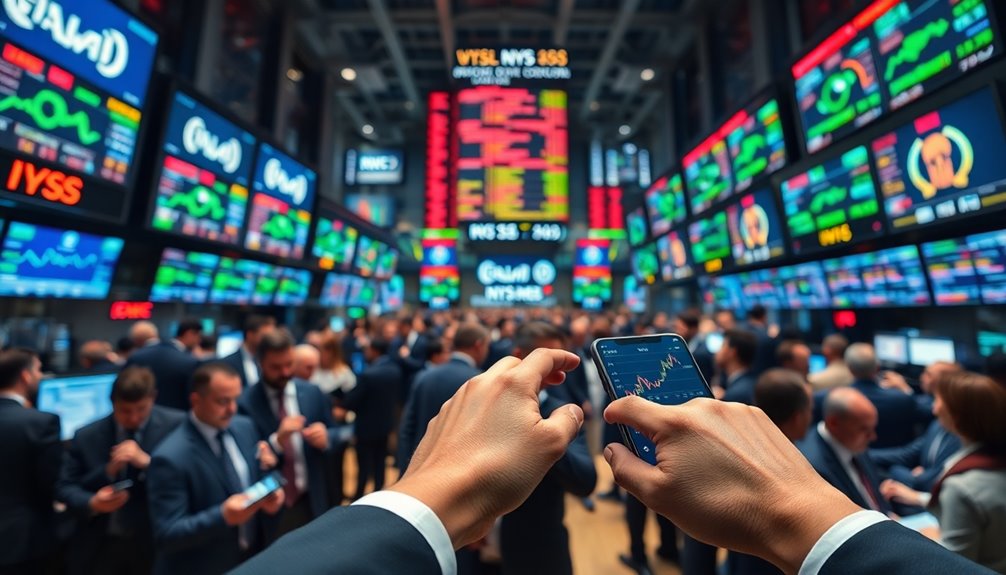Trade volume measures the total number of shares or contracts traded over a specific period. It serves as a crucial indicator of market activity and investor interest. Higher trade volume suggests enhanced liquidity, making it easier for you to execute trades efficiently. When volume spikes during price movements, it often signals strong market sentiment, particularly bullish trends. Conversely, low trade volume might indicate weak interest, which can complicate your trading decisions. Understanding how to analyze trade volume can enhance your strategies and help you navigate market dynamics more effectively. You'll find more insights on this topic as you explore further.
Key Takeaways
- Trade volume measures the total quantity of shares or contracts traded over a specific period, reflecting market activity.
- Higher trade volume indicates increased liquidity, enhancing the efficiency of order execution.
- Elevated trading volume during price movements suggests strong bullish sentiment and market interest.
- Analyzing average trade volume helps traders refine strategies and gauge overall market sentiment.
- Volume dynamics are essential for technical analysis, assisting in identifying trends and potential reversals.
Fundamental Trade Measurement Concept

When you think about the fundamental trade measurement concept, it's essential to recognize that trade volume serves as a key indicator of market activity.
Trade volume measures the total quantity of shares, contracts, or financial instruments traded within a specific period of time. Higher trade volume generally indicates stronger liquidity, which can enhance order execution and lead to tighter bid-ask spreads.
It also reflects investor sentiment; for instance, increasing volume during price movements suggests robust bullish sentiment, while low volume during price increases might signal weakness.
Daily reported trade volume data provides valuable insights, helping you gauge the overall market landscape and make informed decisions based on the dynamics of the financial instruments you're interested in.
Defining Trade Volume's Importance
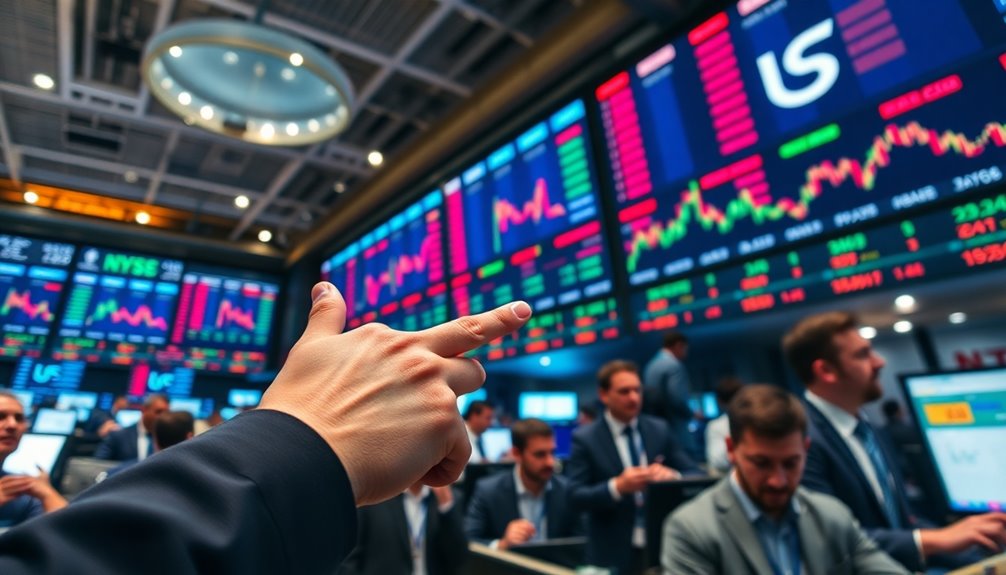
Understanding the importance of trade volume is crucial for anyone navigating the financial markets. Trade volume reflects market activity, indicating liquidity and investor interest.
High trade volume often leads to stronger price movements, making significant changes more meaningful. By tracking average trading volume daily, you can gauge market trends and sentiment, which aids in refining your trading strategies.
Elevated trading volume typically signals increased investor engagement during key events, hinting at potential price volatility.
Moreover, understanding trade volume dynamics is essential for technical analysis, as it helps confirm trends, detect reversals, and evaluate the strength of price movements.
Market Activity Assessment Method
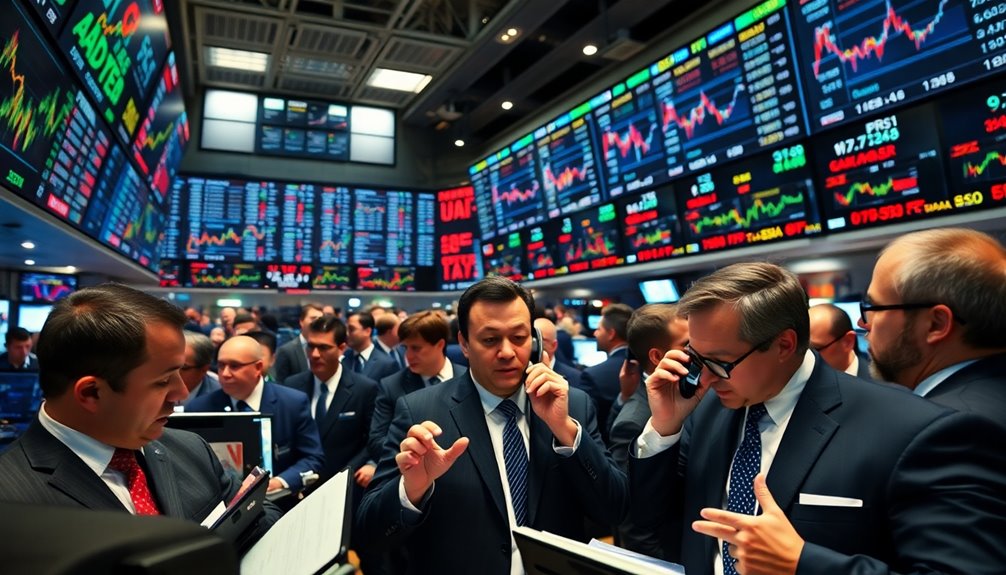
To effectively assess market activity, you need to analyze trade volume as a key indicator. Trade volume reflects the total quantity of shares or contracts traded, providing insights into liquidity and investor engagement.
Higher trade volume often indicates stronger market interest, which can enhance order execution and influence your trading decisions. By examining average volume, you can gauge overall market sentiment and identify potential trading opportunities or risks.
Spikes in volume typically signal significant price trends, making volume analysis vital for technical analysis. Such analysis helps confirm breakouts and reversals, as high-volume price movements tend to be more reliable than low-volume ones.
Ultimately, understanding trade volume allows you to better navigate supply and demand dynamics in the market.
Pros and Cons of Volume

While high trade volume can enhance market liquidity and improve order execution, it also brings potential drawbacks that traders must consider. Increased trade volume boosts trading efficiency, as it tightens bid-ask spreads and confirms price trends, signaling stronger investor participation.
When price rises with high volume, it often acts as a bullish signal, reflecting robust market sentiment. However, be cautious; high volume can also lead to increased volatility, causing sharp price fluctuations that may destabilize the market.
On the flip side, low trade volume indicates weak market interest, making it tough to enter or exit positions without significant price impacts. Balancing these pros and cons is essential for effective technical analysis and successful trading strategies.
Volume Versus Price Trends

As you analyze market movements, paying attention to the relationship between volume and price trends is crucial for making informed trading decisions.
Trade volume acts as a confirmation tool; increasing volume during price rises signals strong bullish sentiment, while rising volume during price declines indicates strong bearish sentiment. A price increase with low volume might suggest a lack of conviction, hinting at a potential reversal.
In contrast, a downtrend with falling volume can show that sellers are losing momentum. High volume during price breakouts reflects greater market participation and strengthens the reliability of the breakout.
Additionally, watch for volume trends to identify exhaustion points, as declining volume in an uptrend may indicate that the upward movement is losing strength.
Market Volatility Impacts Volume
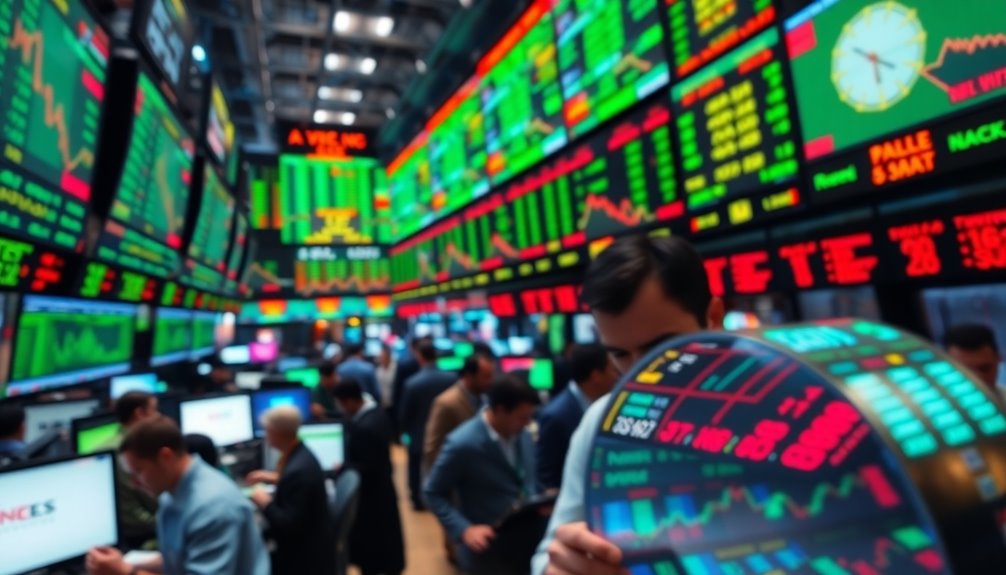
Market volatility significantly impacts trade volume, often driving investors to react swiftly to price changes and uncertainty.
When market volatility spikes, you'll typically see higher volumes, reflecting increased investor activity. Economic events like earnings announcements or geopolitical tensions can trigger these surges, as traders adjust positions in response to potential impacts on security prices.
During high volatility periods, such as market corrections, the urgency to execute trades rises, leading to significant increases in trading volumes. Conversely, in stable environments, trade volume may dip as investors show less urgency to buy or sell.
Additionally, volatility often causes wider bid-ask spreads, influencing your strategy as you seek better execution prices during these turbulent times.
Algorithmic Trading Volume Growth
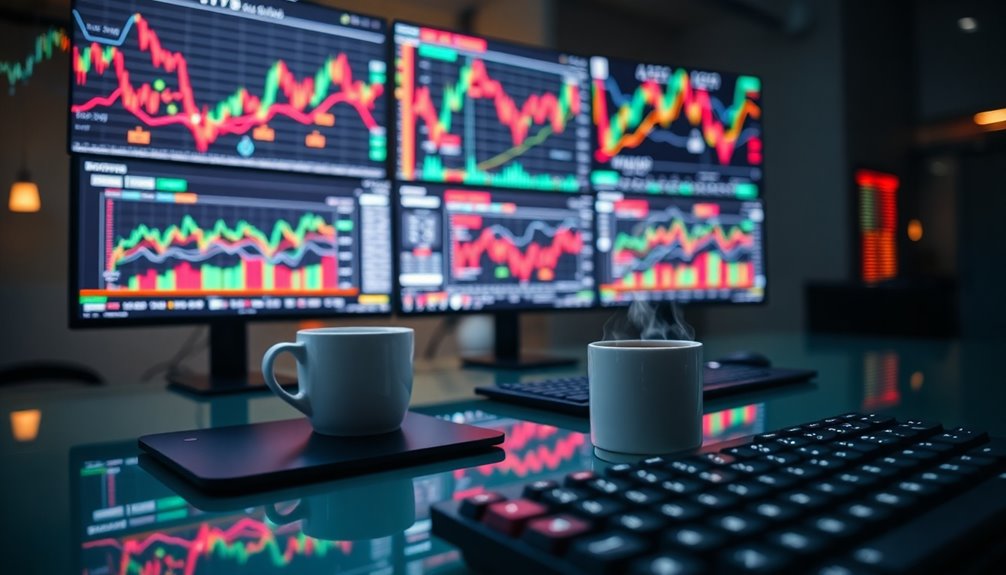
Algorithmic trading has transformed the landscape of financial markets, dramatically increasing its share of total trade volume. As of recent studies, algorithmic trading accounts for about 60% of all trades.
This growth is powered by advancements in technology and market data analytics, allowing for faster trade executions and real-time analysis. High-frequency trading (HFT), a key subset, executes thousands of orders per second, boosting market liquidity and often resulting in higher trade volumes during peak hours.
These trading strategies utilize trade volume data, identifying trading opportunities through indicators like volume spikes. However, this surge in algorithmic trading can also lead to rapid price movements, raising concerns about market volatility and flash crashes when trading volumes shift suddenly.
Volume-Based Entry Timing

Understanding trade volume is vital for making informed trading decisions, especially when considering entry timing.
Volume-based entry timing involves analyzing trading volume alongside price movements to find the best moments to enter trades. When you observe high volume during price breakouts, it signals strong market interest, increasing the chances of sustained price movement.
Conversely, low volume during price increases may indicate a lack of conviction, suggesting that you should wait for higher volume before entering, thereby avoiding false breakouts.
Utilizing volume indicators like On-Balance Volume (OBV) helps assess volume trends, guiding your entry decisions. Additionally, monitoring average daily trading volume can help you spot unusual spikes, signaling potential entry points for capitalizing on significant price movements.
Frequently Asked Questions
What Does Trade Volume Mean?
When you think about trade volume, you're considering the total amount of assets or shares traded within a certain time frame.
It reflects market activity and liquidity. Higher volumes usually mean more investor interest, confirming strong price movements, while lower volumes might indicate weak participation and increased volatility.
Is Higher Trading Volume Good?
Higher trading volume's generally good for you as it indicates strong market interest and increased liquidity.
This means you can execute your orders more efficiently and often benefit from tighter bid-ask spreads.
When prices rise alongside high volume, it confirms bullish sentiment, strengthening your confidence in the uptrend.
Conversely, if volume spikes during price declines, it might signal strong selling pressure, which could lead you to reconsider your investment strategy.
What Is an Example of a Trade Volume?
An example of trade volume is when you see a stock like Tesla trading 15 million shares in one day. That high number shows significant market activity and investor interest.
Similarly, in the commodities market, if 10,000 contracts of gold are exchanged in a day, it reflects active trading.
Each of these instances illustrates how trade volume can indicate the level of engagement in various markets, helping you gauge market dynamics effectively.
How Do You Measure Volume of Trade?
To measure the volume of trade, you count the total number of shares or contracts traded within a specific timeframe.
You can do this daily or over any period you choose. Just add up all the transactions to get a complete picture.
Monitoring this data helps you understand market activity and liquidity, which can guide your trading decisions.
Conclusion
In summary, understanding trade volume is crucial for navigating the markets effectively. It helps you assess market activity, identify trends, and make informed decisions. While volume provides valuable insights, remember to weigh its pros and cons. Keep an eye on how market volatility can influence volume, especially with the rise of algorithmic trading. By focusing on volume-based entry timing, you can enhance your trading strategy and potentially increase your success in the ever-changing market landscape.
